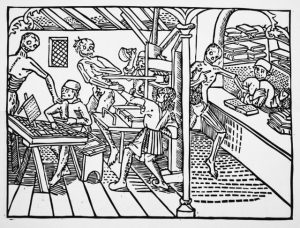 As you know I vowed not to make a historical printing press… Well, guess what… It just happened, I couldn’t help myself.
As you know I vowed not to make a historical printing press… Well, guess what… It just happened, I couldn’t help myself.
In the first week of january I was cleaning up the shop. Especially the machine shop was a real mess. Sawdust, curls and pieces of wood everywhere. Parts of unfinished projects and remains of completed ones. One of the hard things of cleaning is that my mind starts wandering and the most ludicrous ideas come up. Some are quite good and completed quickly (like two cyclone vacuum cleaners made of orange traffic cones, working perfectly). But others are more questionable.
A printing press
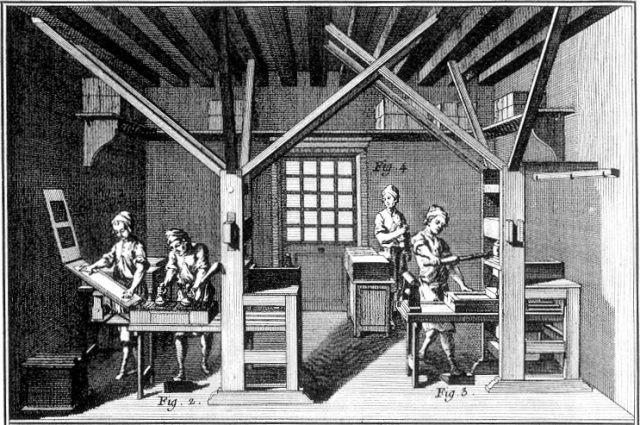
The desire of making a printing press is about five years old. When I first saw Stephen Fry’s documentary on the Gutenberg press and the attempt to recreate one. Printing and publishing has always interested me, and over the years I have made countless designs for posters, invitations, brochures, flyers and even books. Besides the fact that it has been one of the great revolutions in our history. It meant a huge step in the availability of information, giving a boost to the cultural and intellectual uprise of the renaissance. Just as important as the invention of agriculture, fire or the wheel.
An excuse
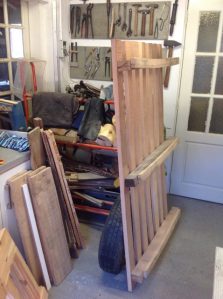 Sorting out and cleaning the mess in the shop made me realize something; I already have a printing press, it’s only not assembled yet… (insert halo emoticon here 😇)
Sorting out and cleaning the mess in the shop made me realize something; I already have a printing press, it’s only not assembled yet… (insert halo emoticon here 😇)
All the parts are there, frame, platten, print bed, even the large screw…
A friend regularly gives me beechwood pallets. He feels it’s a waste to throw them away or only use them as firewood. I take these pallets apart and use them for hobby projects, furniture, parts of the little free library, tools and reenactment accessories.
The screw is sourced from another place. One of my friends is an electrician and recently 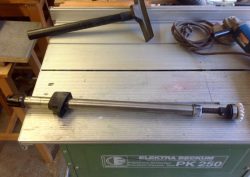 replaced some automatic fence openers. The old ones were discarded. I took them out of the scrap bin to strip them for useable parts. Inside the arms is a large threaded rod and nylon bolt. Designed to move quickly with a fair amount of torque it has 4 threads around the center. At the time I didn’t have a purpose for it, but thought it might come in handy later. Axles like these can also be used to built CNC machines…
replaced some automatic fence openers. The old ones were discarded. I took them out of the scrap bin to strip them for useable parts. Inside the arms is a large threaded rod and nylon bolt. Designed to move quickly with a fair amount of torque it has 4 threads around the center. At the time I didn’t have a purpose for it, but thought it might come in handy later. Axles like these can also be used to built CNC machines…
Design
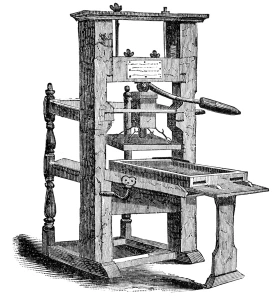 My first idea was to make a Gutenberg style press like in the Stephen Fry documentary. But there are some objections to this. For one is material, the Gutenberg or Durer presses are beautiful but very large and solid. They use a wooden screw to provide pressure to the platten. But the pallet beech has limited dimensions and this the press needs to be (at least a bit) portable and ‘compact’. The Gutenberg press is beautiful, but very large and solid. The ‘common press’, a later model, is more suitable. Because it can be made in such a way that the whole press can be taken apart into three basic elements:
My first idea was to make a Gutenberg style press like in the Stephen Fry documentary. But there are some objections to this. For one is material, the Gutenberg or Durer presses are beautiful but very large and solid. They use a wooden screw to provide pressure to the platten. But the pallet beech has limited dimensions and this the press needs to be (at least a bit) portable and ‘compact’. The Gutenberg press is beautiful, but very large and solid. The ‘common press’, a later model, is more suitable. Because it can be made in such a way that the whole press can be taken apart into three basic elements:
- The carriage, holding the type and paper during printing.
- It rests on the ribs, and moved in and out with a crank.
- The screw and platten are held in the standing frame.
- A front leg to support the front of the ribs.
With some creative stacking the whole thing can be made foldable for transportation; even small enough to fit on a hand trolley (which is allowed in public transportation in the Netherlands).
Labels and reenactment
The reason for wanting a press is twofold. Up to the 18th century, labels in musical instruments were relief printed. These were made with movable type.
Later we see more and more engraved labels appear in guitars.
Historic vs hysteric…
There are multiple levels of historical “correctness” when reconstructing historical artifacts. Both in the object itself (materials, construction) as in the way it is made (techniques and technology used). This is often discussed among reenactors. Especially regarding clothes. You can make historical costumes out of nylon fabric. But we all agree that this wasn’t used before the 20th century. So for a historical ‘correct’ costume you try to use materials that were used at the time.
Some go pretty far in this, while others have different standards. Sometimes this even leads to disputes between reenactors. But while everybody tries their best, sometimes there are limits to what you can do. Often guided by available time and (financial) resources. Our way is to start with a historical informed set of clothes, not completely correct – some parts are made of cotton – and replace this over time.
This is also the case with other materials. It’s “not done” to use screws, plywood, particle board or plastics. But sometimes people do use them. I have seen people go absolutely nuts over this, getting in a hysteric cramp because of a hidden screw. Well, I don’t think that’s necessary. It’s the effect what we try to give and communicate to the public attending the events. And the public does know that we aren’t really from the middle ages, and that we make a lot of the things ourselves.
For the press I have decided that in this version screws may be used. I keep them out of direct sight. It has to be functional first. Maybe on a later date when funds and space allow it, I will make a more accurate version.
Slightly Smaller
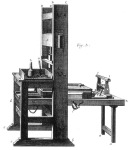 There is a very detailed description of the ‘common press’ in Diderot’s Encyclopedia. Fantastic drawings show how the press was constructed and used. This will be my starting point for this reconstruction. To allow the press to be used in the shop, and keep it portable, this version will be up to 3/4 of the original scale. This also allows it for children to be used. At most events I have my own work as lute maker.
There is a very detailed description of the ‘common press’ in Diderot’s Encyclopedia. Fantastic drawings show how the press was constructed and used. This will be my starting point for this reconstruction. To allow the press to be used in the shop, and keep it portable, this version will be up to 3/4 of the original scale. This also allows it for children to be used. At most events I have my own work as lute maker. 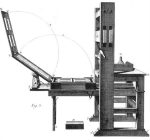 But printing is something anybody can learn quite easily. So it’s the idea to get family and friends involved to operate the press. When they explain the working of the press to the public, change the paper and ink the plates. When children operate the lever, making their own prints. Allowing them to get an experience of how printing works.
But printing is something anybody can learn quite easily. So it’s the idea to get family and friends involved to operate the press. When they explain the working of the press to the public, change the paper and ink the plates. When children operate the lever, making their own prints. Allowing them to get an experience of how printing works.
Spare time
I make this press during forgotten hours and weekends in the shop. It’s completely different to what I normally make. This isn’t fine woodworking, it’s more like making a workbench or barn. Large mortises and tenons. Whacking away with hammers and chisels…
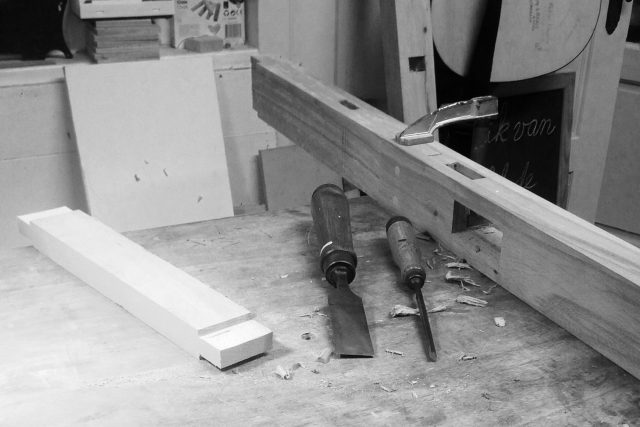
to be continued…


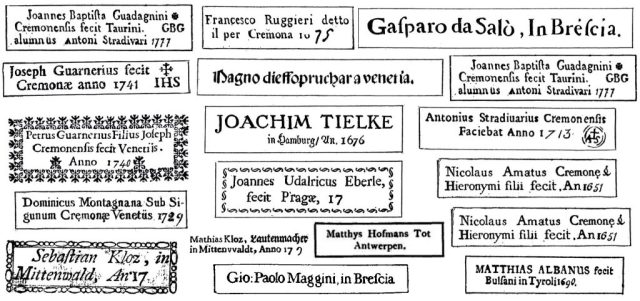




Great project you have in hands! I’ll be following to see the progress. I’m a medieval reenactor and last year I started also this kind of project, although the press I built was much smaller. But still it worked just fine and in the future, I hope I can build a bigger and better press. 😉 Keep up the good work! (some of my prints here: https://www.flickr.com/photos/jorel/)
LikeLike